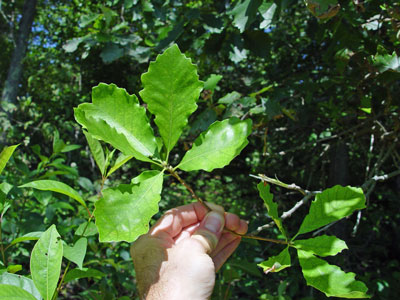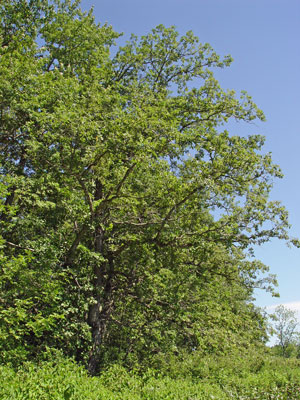DACF Home → Bureaus & Programs → Maine Natural Areas Program → Communities, Plants, and Animals → Rare Plants → Quercus bicolor

Quercus bicolor Willd.
Swamp White Oak
- State Rank: S1
- Global Rank: G5
- State Status: Threatened
Habitat: Bottomlands, stream margins, and swamps. [Forested wetland]
Range: Southern Maine and southern Quebec to southern Minnesota and Nebraska, south to southern New England, Long Island, Delaware, Maryland, northern West Virginia, upland to Georgia and Kentucky, Arkansas and Oklahoma.

Aids to Identification: Quercus bicolor is a member of the white oak subgenus, a diverse group of species that have leaves with rounded lobes (as opposed to bristle-tipped lobes in the red oak group) and acorns that mature in one year. Swamp white oak can be distinguished from other white oak species in Maine by the following combination of characters: ovate leaves, widest above the middle, with 6-10 pairs of low but fairly even lobes (like rounded teeth); hairless buds; and acorns on stalks that are more than 3 cm long. It can be difficult to distinguish from bur oak (Q. macrocarpa), which occurs in similar habitats, unless one has buds and/or acorns. Q. macrocarpa usually has a deep sinus near the middle of the leaf, but leaf shape and lobing are very variable, even among leaves on the same tree. The larger branches of Q. macrocarpa will have corky ridges along them and are absent in Q. bicolor. Common white oak (Q. alba) is an upland species with leaves that have longer lobes than those of Q. bicolor. Chestnut oak (Q. montana) is also an upland species, found in Maine only in dryish rocky woods on and around Mt. Agamenticus and has leaves which are much narrow in outline though similarly lobed. Hybridization between Q. bicolor, Q. alba, and Q. macrocarpa has been reported. Hybrids would be very difficult to identify. When in doubt, press a small branch with a few leaves and either buds or acorns and send to the University of Maine herbarium.
Ecological characteristics: Swamp white oak is a tree of hardwood floodplain forests, basin swamps, or vernal pools. It grows with ash (Fraxinus spp.), silver maple or red maple (Acer saccharinum and A. rubrum, respectively), and occasionally with Q. macrocarpa.
Phenology: Acorns mature in the first year, ripe in September - October.
Family: Fagaceae
Synonyms: None noted.
Known Distribution in Maine: This rare plant has been documented from a total of 11 town(s) in the following county(ies): Kennebec, Knox, Somerset, Waldo, York.
Reason(s) for rarity: At northern limit of range; not rare southward.
Conservation considerations: Populations are small and could be eliminated by logging.